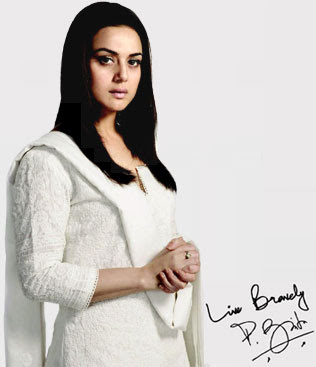
Showing a bit of skin is in. No it's not — not if you're blonde and white and come from down Texas way. Political protests in Maharashtra and West Bengal that have forced American cheerleaders at IPL matches to cover up and behave are, once again, a fine exhibition of the time-dishonoured Indian traditions of hypocrisy, xenophobia and misplaced prudery. It's cultural assault by the West when foreign women show cleavage, wiggle waists and indulge in high-kicking steps in stadiums — but it's lip-smackingly delicious when the country's cinemas and TV screens spill over with Kareena Kapoor, Bipasha Basu, Preity Zinta, Shilpa Shetty, Mallika Shehrawat and Rakhi Sawant do the same. Compared to what Bollywood's babes get up to in public, American cheerleaders are innocents abroad. Surely more Indians are intimate with Bipasha's state of undress in Jism, Kareena's extensive, wafer-thin waistline in Tashan and Preity's micro-minis in Karan Johar movies than they are with Exhibits A, B and C of a few visiting cheerleaders?
Double standard or double vision? A case of both. Notions of sexual suggestiveness vary from place for place — Japanese geisha blacken their front teeth as provocation to clients — and distinctions between the pure and impure are variable. Prurience, like innocence, lies in the eyes of the beholder.
In America, skimpily-attired cheerleaders are as much a tradition as items girls and extras in Hindi film dance numbers. Cheerleaders are an organised group, their vocation being both specialised and hazardous. There are nearly 4 million cheerleaders practising their art — a combination of calisthenics and sexy gyrations — on college campuses and playing fields. In the US there are annual cheerleader awards, a wide-selling cheerleader magazine and a cheerleading foundation. About 25,000 cheerleaders are injured every year and require medical attention.
By contrast, Bollywood's dancers and Mumbai's dance bar girls, for all the skin they show and the dangerous lives they lead in the twilight zone, are unprotected and beleagured — exploited by clients, employers and the police, and harassed by ultra-conservative politicians bent on enforcing their puritanical moral code. For a harrowing account of Mumbai's demi mondaine there is the detailed real-life of Monalisa, a bar girl in Suketu Mehta's award-winning nonfiction narrative Maximum City. Given half a chance any of these Indian girls would gladly swap their lives with American cheerleaders — a Green Card would guarantee a higher safety standard than a G-string.
"Just a few cheering girls on the sidelines and people are upset … Entertainment is a part and parcel of sports worldwide," IPL boss Lalit Modi was quoted as saying the other day. Good point. When it comes to sex, Indians have a long and richly diversified repertoire of where to seek — and how to find — such entertainment. Current ideas of political correctness may prevent a truthful admission but some of the greatest stars of the Indian screen and of musical gharanas are descended from a lineage of courtesans, kothewalis and devadasis. Indian cinema owes its oldest debt to these strong-willed and talented women who made the transfer to screen in the early chapters of its history. An elementary reading of the Bollywood genre of storytelling is a confirmation of its voyeuristic, erotically charged content in music and dance. What else have the long lineup of vamps, mujra queens, nautch girls and cabaret artistes (such as Helen) been purveying all these years?
Nor should the transition from the wet sari look to Western-style sartorial revelations be that surprising. The international fashion columnist Suzy Menkes was in India recently attending one of the fashion weeks. Asked about the most noticeable change in India she had observed in 17 years of visiting the country, she said: "The declining use of the sari. To me it is one of the most glamorous and sexy garments ever created. But I am sad, though not surprised, to see fewer women wear it."
Fashions change, in sex and style, as in any department of life. But the Indian habit of navel-gazing does not.
0 comments:
Post a Comment